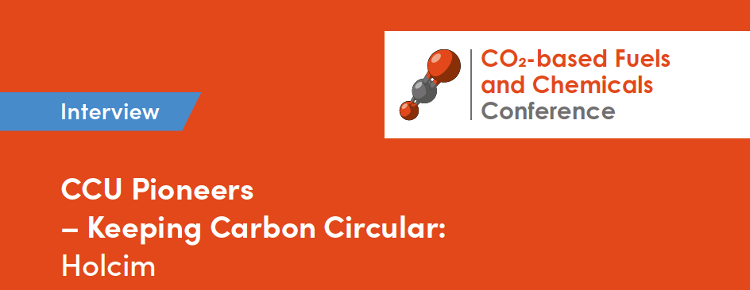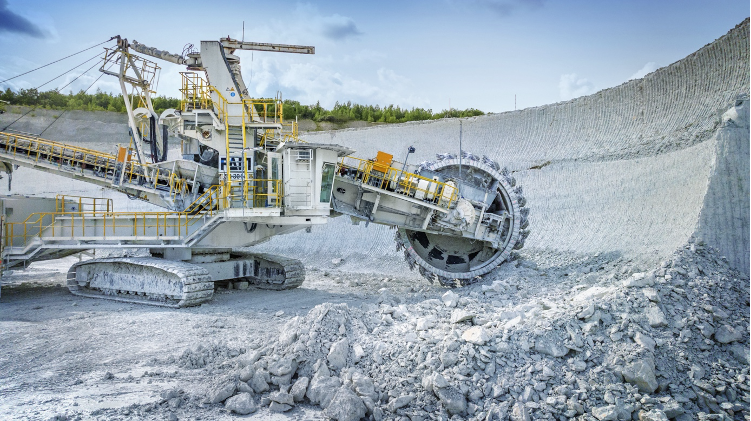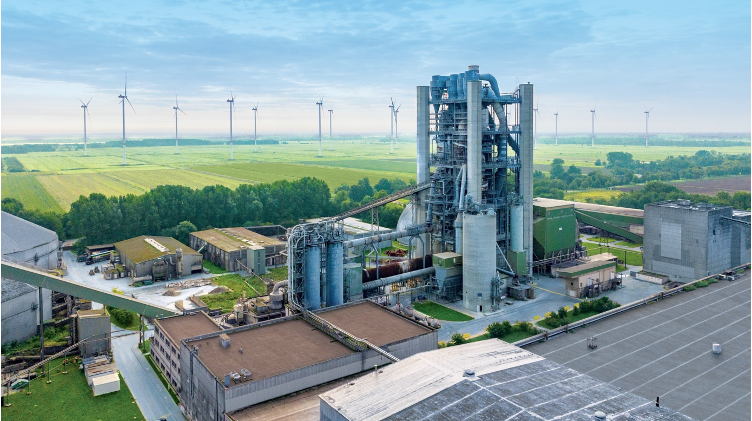CCU Pioneers – Keeping Carbon Circular: Holcim
Interviewpartner: Florian Kleinwächter (Senior Business Development Manager CCU/S)

With 5-8% of global CO₂ emissions coming from cement production, a $300B+ industry is facing multiple challenges. Especially here, Carbon Capture and Utilization (CCU) could transform CO₂ into methanol, e-fuels, and next-generation building materials. Holcim is strategically integrating Carbon Capture and Utilisation (CCU) into its operations to achieve carbon neutrality in cement and concrete production. A key focus is transforming captured CO₂ into a valuable raw material for various industrial applications, aligning with circular economy principles. From pioneering a carbon-neutral plant in Lägerdorf to innovative capture technologies, Holcim is committed to turning CO₂ into a valuable resource. Florian Kleinwächter from Holcim shares insights into this transformative approach.
Holcim is a key sponsor of the CO₂-based Fuels and Chemicals Conference 2025. This prescigious conference is scheduled to take place from April 29-30, 2025, in Cologne, Germany, with options to attend online, highlighting the latest advancements in Carbon Capture and Utilization (CCU) technologies.
To learn more about Holcim's CCU strategies and other advancements in the field, attendees can visit the conference to engage with industry leaders and experts.
1. Innovation & Sustainability
With the concrete sector being one of the biggest emitters of CO2, how does Holcim integrate Carbon Capture and Utilization (CCU) into its sustainability strategy to achieve carbon neutrality in cement and concrete production?

Holcim’s pathway to Net Zero is clear. There are different ways to reduce CO2 emissions in cement production and we will pursue them all to reach our commitments, we will reduce our clinker factor, use alternative fuels and raw materials, and increase our use of renewable energy.
Around two thirds of the cement industry’s CO2 emissions come from the raw materials themselves and are emitted during the burning process. These emissions are inevitable and would persist even if cement kilns were operated entirely with renewable energy.
However, concrete serves as the foundation of the world. From houses, roads, and bridges to factories, it is utilized almost everywhere. Additionally, the transition to sustainable energy needs to be built – railway lines, tunnels or bridges for trains, foundations and towers for wind turbines. The world requires innovative solutions to continue utilizing this indispensable building material without jeopardizing our future. A technological leap is imperative for environmentally friendly cement production.
That is why we are scaling up advanced technologies such as carbon capture, utilization and storage (CCUS), which will make an increased contribution in terms of reaching our targets post-2030.
The ambitious plan that we are pursuing at all three of our cement plants in Germany is to develop the captured greenhouse gas CO2 into a valuable raw material, for example as a basic material in the chemical industry for the production of plastics. When their first life cycle ends after as much equivalent recycling as possible, they can be utilised again in the cement plant, whereby the CO2 is captured again and used as a raw material. This creates a CO2 cycle in which the gas does not escape into the atmosphere.

2. Breakthrough Technology
Holcim is currently building the first carbon neutral cement plant in Laegerdorf. How does your Carbon2Business project address the unique challenges of carbon capture in the cement industry?
With its decarbonisation strategy and the steps that have been taken, Holcim is a first mover in this area. The capturing technologies necessary for the sustainable transformation of cement plants are in different early development stages and need to be tested. That is why we chose to run a widespread approach testing different technologies at different plant sites in Germany.
First in line is our plant in Lägerdorf, where we are planning a climate-neutral cement plant using 2nd generation oxyfuel technology, which can capture CO2 almost completely.
Lägerdorf as a site for carbon capture offers the additional advantage of a strategically favorable geographical location. This includes excellent access to sustainable energy sources and close proximity to Brunsbüttel, which presents potential CO2 offtakers within the ChemCoast Park, as well as a port for onward transportation of the captured CO2.
In Höver, Holcim is testing a CO2 capture plant based on membrane technology with the aim to demonstrate the efficiency of this technology on an industrial scale in order to potentially capture 90 per cent of CO2emissions. In addition we are looking at pressure swing absorption (PSA) technology.
At the Beckum cement plant, we are using amine scrubbing technology to capture CO2 and also test a separate oxyfuel calciner with a subsequent carbon purification unit (CPU).
With all these projects we are well prepared for the challenges the way to Net Zero brings. In addition there is a regular exchange within the Holcim Group to benefit from all insights that are won by the activities on an international level.
3. Challenges & Opportunities
What are the biggest challenges Holcim faces with regard to CO2-based products, and what opportunities do you see for these solutions to transform the cement sector in the future?
Many manufacturers already offer climate-friendly cements. For example, the Holcim ECOPlanet series reduces the carbon footprint by over 50 percent compared to standard cement. Key factors here are the substitution of fossil fuels and optimized formulations. Their market share of Holcim Germany's sales volume rose from 2.9 to 16.9 percent. We see the same trend in concrete.
In addition to the decarbonization of our products, the circular economy is at the heart of our corporate philosophy. Building materials should never become waste, and the most important raw material sources of the future should no longer be exclusively sand and gravel pits, and quarries, but rather existing buildings in cities.
As a consequence, when it comes to CCUS, Holcim’s strategy is based on the belief that CO2 is a valuable raw material. Thus, we are taking into consideration all options the CO2 use case market has to offer. One important prerequisite for the development of the CO2 market is clarity in terms of regulations and laws such as the KSpTG. That has been a challenge over the last months and we hope to move into a safer and more plannable situation now.
As for the CO2 based products, we are working in an environment that is still evolving on many levels. Many of the promising product developments in this area are still in relatively early development stages, so it is not easy to create realistic business cases right now. A good example are materials that result from a mineralisation process that binds CO2 permanently. These materials can be used as additives in the cement production - thus creating a circular CO2 process. The testing process necessary to get the material certified for construction, however, is very complex and time consuming. At the same time projects in this area can contribute enormously to the decarbonisation of cement production.
In general we see a lot of movement in the area. Many start-ups develop solutions to bind and/or use CO2 in various products. It is important that the emitting industries join in these activities, support them and search for solutions within their own production environments in order to drive the economy towards a sustainable future - from an ecological and economical perspective.

4. Collaboration & Industry Dynamics
How does Holcim collaborate with industry partners, research institutions, and policymakers to accelerate the adoption of CCU technologies?
Collaboration is a key to a carbon free economy. Holcim pursues that on all levels. We have recently started a project that represents a truly circular CO2 value chain. Part of the project are three start-up companies, two industry representatives and a university. The value chain combines a capturing technology with a direct air capturing process and leads to two different use cases - one mineralisation process and one chemical process. This initiative demonstrates a practical model for a closed CO2 loop, providing startups with a vital testing ground for their technologies. Furthermore, it serves as a critical foundation for engaging with regulatory bodies, accelerating the recognition of diverse processes as permanent CO2 binding solutions, and thus advancing their eligibility within the EU ETS.
At Holcim, we firmly believe that the future of the economy lies in sustainable and innovative solutions. Therefore, we are extremely open to exchanging with companies and experts who are engaged in CO2utilization scenarios.
We are particularly interested in contacts and ideas from the chemical industry. The chemical sector has extensive expertise in the conversion of substances and can make crucial contributions to the development and scaling of CO2-based products. We are convinced that only through cross-industry collaboration and the exchange of knowledge and experience can real change be achieved.
To foster this collaboration and advance the development of CO2 utilization technologies, we at Holcim have established a specialized CCUS (Carbon Capture, Utilization and Storage) team. This team is dedicated to researching and implementing innovative solutions and is available to answer your questions and exchange ideas.
We warmly invite you to get in touch with us and work together towards a sustainable future. Your ideas and expertise are invaluable to us. Let's explore together the opportunities that CO2 utilization offers.
Source: nova-Institute, original text, 2025-04-22.
